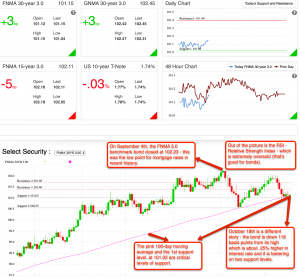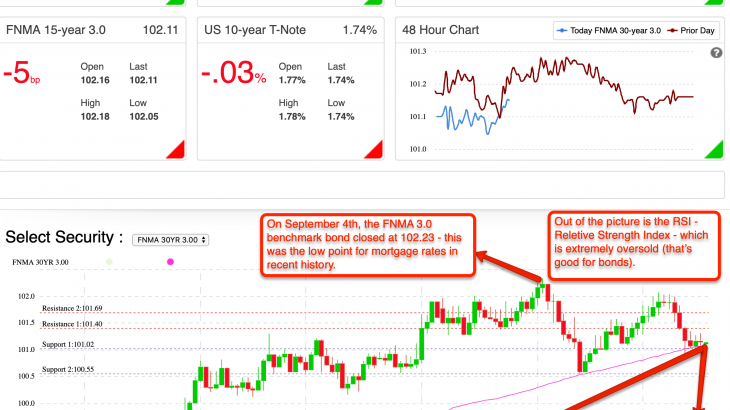Deceptive advertising is a HUGE pet peeve of mine. For me, it’s important to be 100% honest all the time. Spinning things to make something look better than it is in an effort to get people to make a decision for your own financial gain doesn’t sit well with me. I’ve never played that game and I never will. I say this because I hear radio ads about how mortgage rates have fallen. WHEN? They have actually gone up over .25% since September 4th. I see billboards advertising a given rate but if your situation isn’t in the tiny little box that that rate works for (purchase loan, super high credit scores, 20% or more down, the ability to buy the rate down, etc.) then your actual rate is completely different than the advertised rate.
How Mortgage Rates Are Determined
It’s important to understand that bond prices move inversely to interest rate. This means that as investors are buying bonds and pushing prices higher, interest rates go down. When enough investors sell and push mortgage bond prices down, the mortgage rates rise. Base rates for conventional mortgages are determined by the FNMA benchmark bond. Beyond that, LLPAs (loan level pricing adjustments) for a borrower’s specific situation determine their interest rate. The main categories that impact a given borrower’s rate are 1) occupancy type – owner occupied vs. investment property; 2) LTV – the lower the LTV, the better the rate, especially, when you get to 80%, then 75%, 70%, and so on; 3) credit score – 680 is about as low as you want to be to get a decent rate on a conventional loan but at 700 and 720 there are fairly decent improvements, and there are smaller improvements at 740 and 760; 4) financing purpose: purchase money mortgages have better rates than cash-out refinances. A cash-out refinance at 70 or 75% LTV has a better rate than one at 80% LTV; 5) property type – single family residences are preferred over condos and townhomes, for instance.
Here is today’s mortgage bond chart as of about 8:50 or so MDT:

There are a couple of important things to note. First and most importantly is that the benchmark bond is about 118 basis points lower in price today than it was on September 4th. The other important thing is that the subsequent high after the September 4th high is lower than September 4th. This means that future highs are likely to be lower which means rates could trend up a bit from here…with this caveat: the bond is currently at a very strong support level AND the Relative Strength Index (not in the picture) is severely oversold). Because of these two things, I would expect investors to start buying bonds, pushing prices up and rates down.
The Economy
While many economic indicators are still strong, several of them aren’t as strong as they were just a few months ago. While I’m not sold on the idea that we’ll have a recession in the near future, I do think that a resolution of the China trade wars will go a long way in getting our economy back on track. That said, the Fed is adding to its balance sheet which is good for mortgage rates and they have also eased the Fed Funds rate at the last two meetings and the odds for another easing at the next meeting has increased from 50% to 90%. This is also typically good for mortgage rates. Twice in recent months we’ve seen the major indices of the stock market (DJI, NASDAQ, and S & P) test their all-time highs and have sold off when they got at or near them. This shows a lack of investor confidence.
Where do we go from here?
If only I had a crystal ball…However, I do think that we will see mostly sideways trading within a fairly narrow range as far as the mortgage bond market and interest rates are concerned. Perspective is important and here’s a little dose for you: while having access to mortgage bond charts like I do is great and understanding them is even better, it doesn’t guarantee anything. I can make good educated guesses with these tools and it often works out to the benefit of my clients but it’s not perfect. The takeaway is that if you lock at 4.25 when your friend got 4% or, heaven forbid, 3.875%, it’s not a big deal. First of all, you don’t know what factors contributed to that difference in rate – see above for a reminder of the five main factors that contribute to a specific borrower’s rate. Locking at different times also plays an important part in what rate you get relative to your friend – the mortgage bond market is actively traded so rates move continuously throughout the day. In the end, any rate in the 4s, or 5s for that matter, is so much better than the historical average and, by all means, don’t let your parents hear you complain that your rate is 4.5% if they had a mortgage in the early 80s when rates were in the double digits.
If you’d like to know what rate you might be able to get, contact me at 702-812-1214 / 801-893-1737 or jed.wunderli@noblehomeloans.com so that we can go over your specific scenario and get you a proper quote.




